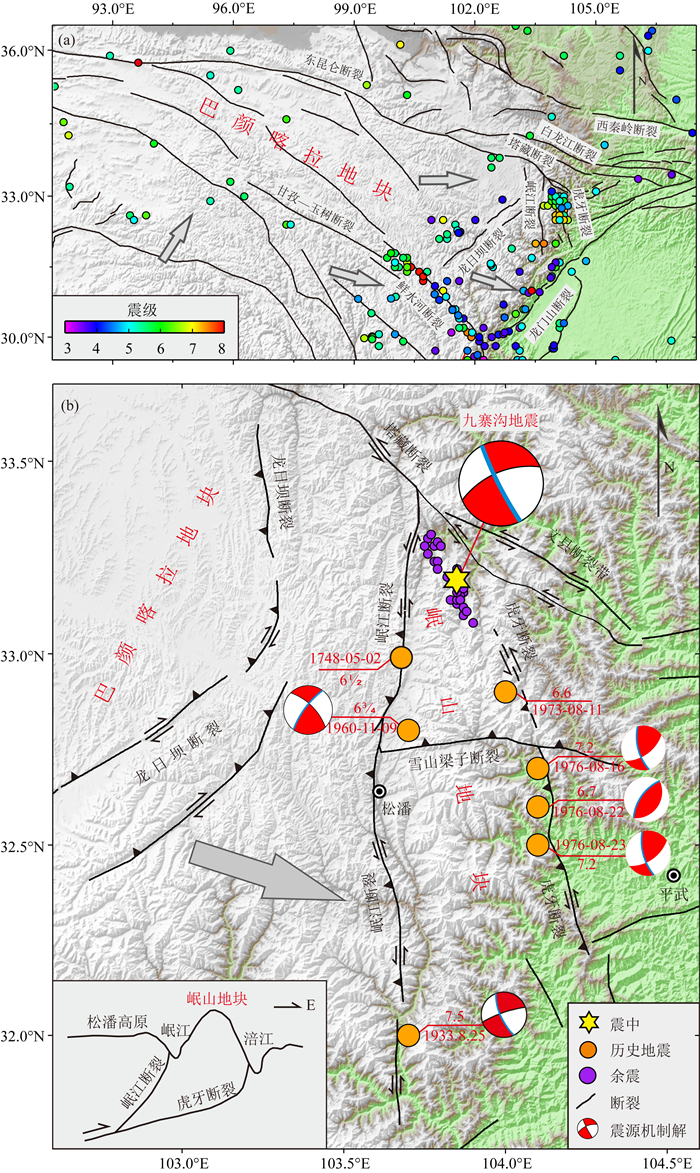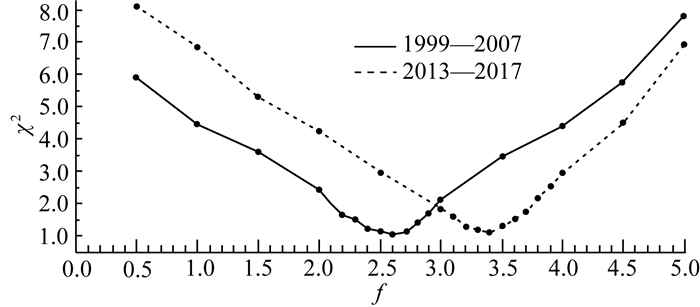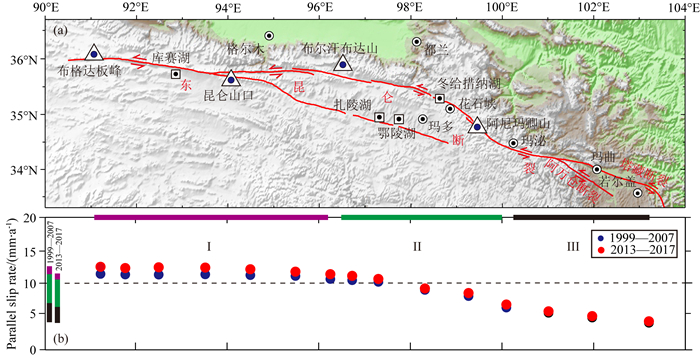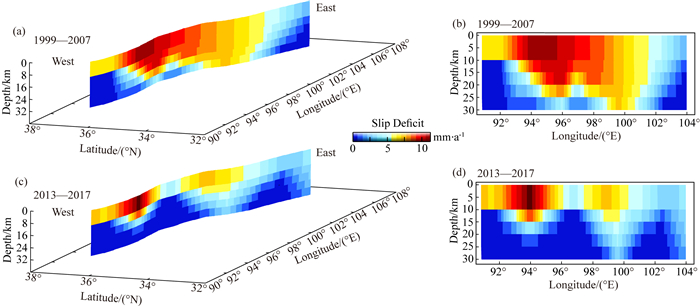2017年8月8日, 岷山地块的北端, 四川省阿坝州九寨沟地区发生MS7.0地震(Xu et al., 2018), 据美国地质调查局(USGS)震源机制解(图 1), 发震断层走向153°, 倾角84°, 滑动角-33°, 属陡倾角走滑型地震(http://www.earthquake.usgs.gov/).岷山地块是新构造时期以来强烈隆升的断块山地, 其东西边界分别为虎牙断裂和岷江断裂(周荣军等, 2000; 许康生和曾文浩, 2016).受NNW向的主压应力作用, 岷江断裂和虎牙断裂南段表现为推覆逆掩运动, 易于能量的积累.九寨沟地震的发震断层位于虎牙断裂的北侧, 属东昆仑断裂带东端分支断层之一, 与岷江断裂和塔藏断裂构成了东昆仑断裂带东端向东散开的“马尾状”构造(徐锡伟等, 2017).塔藏断裂和虎牙断裂北段及其附近其他分支断裂分解了大部分东昆仑断裂带的左旋走滑分量, 岷江断裂、虎牙断裂南段等作为横向挤压构造, 吸收了东昆仑断裂带剩余的左旋走滑运动, 并将巴颜喀拉块体的水平运动转换为青藏高原东缘岷山强烈隆升(Kirby et al., 2000; Li et al., 2017).岷江断裂和虎牙断裂历史上曾发生过多次6.0级以上的地震, 1933年叠溪7.5级地震和1960年漳腊地震均发生在岷江断裂上; 1976年8月16至23日, 虎牙断裂的南段先后发生7.2、6.7和7.2级三次逆冲型地震序列.2017年九寨沟MS7.0地震正是左旋走滑的东昆仑断裂带在东端继续向东扩展的结果(任俊杰等, 2017).

|
图 1 构造背景 (a)青藏高原周缘主要活动断裂和历史地震.黑色实线是主要活动断裂; 彩色圆圈表示历史地震, 不同颜色代表不同震级; 灰色箭头表示构造应力方向; (b)九寨沟地区主要活动断裂, 余震和历史强震分布.黄色六角星为九寨沟地震的震中位置; 紫色圆圈是震后16 h内ML≥2.5的余震分布; 橙色圆圈是历史强震; 沙滩球表示九寨沟地震和历史强震的震源机制解. Fig. 1 Tectonic settings (a) Major active faults and historical earthquakes around the Qinghai-Tibet Plateau. The solid black lines are the main active faults; the colored circles represent historical earthquakes and the different colors represent different magnitudes; the grey arrows indicate the direction of the structural stress. (b) Distribution of main active faults, aftershocks and historical strong earthquakes in Jiuzhaigou area. Yellow hexagram is the epicenter location of the mainshock, orange circles are some historical earthquakes and purple circles are the aftershocks (ML≥2.5) within the first 16 hours (Data comes from China Earthquake Networks Center, CENC). Black solid curves are main active faults. Beach balls are the focal mechanism solutions of the mainshock and historical earthquakes. |
巴颜喀拉块体位于青藏高原中部, 是青藏高原物质向东“逃逸”的重要构造单元之一, 其运动模式受控于南、北边界大型走滑断裂(邓启东, 2010).近20年来巴颜喀拉地块边界附近发生过数次强震, 1997年玛尼MW7.5地震, 2001年昆仑MW7.8地震、2008年于田MW7.2、2008年MW7.9汶川地震、2010年MW6.9玉树地震、2013年MW6.6芦山地震、2014年于田MW6.9地震和2014年康定MW5.9地震(Huang et al., 2017; 徐晶等, 2017).九寨沟MW6.5地震是巴颜喀拉块体边界带发生的又一次地震破裂事件, 表明巴颜喀拉地块周缘主要活动断裂仍然处在应力调整状态中(Wang et al., 2017).库仑应力被广泛应用于地震应力触发和主要活动断层上的应力扰动研究以及基于速率-状态摩擦模型和库仑应力模型的地震复发概率评估(Toda et al., 2008; Toda and Stein, 2013; Wang et al., 2017).九寨沟地震后,部分研究者基于库仑应力分析手段研究了历史地震引起的同震和震后库仑应力变化对九寨沟地震的应力触发效应(徐晶等, 2017; 汪建军和许才军, 2017), 而缺少关于主要活动断裂, 如东昆仑断裂, 对九寨沟地震的震间应力加载或卸载的研究.
东昆仑断裂带, 是印度板块向欧亚板块俯冲过程中在青藏高原内部沿东昆仑古构造缝合线形成的以左旋走滑运动为主的一条大型左旋走滑岩石圈断裂带, 也是青藏高原北部秦祁昆块体与可可西里—巴颜喀拉块体的分界活动断裂, 全长约2000 km, 平均走向270°~290°, 呈略向NNE凸出的弧形(李陈侠等, 2010).作为东昆仑断裂东端分支断层, 九寨沟地震的发震断层的应力积累状态与东昆仑断裂的活动性息息相关.深入研究东昆仑断裂对九寨沟地震的应力加载或卸载作用, 对认识活动断裂之间的相互作用、震间应力应变积累状态和地震危险性具有重要的现实意义.GPS观测数据有效反映现今地壳形变状态(Zhu and Shi, 2011; Ding et al., 2014), 揭示的中国大陆现今运动场清晰地表现出:第四纪断裂十分发育, 将中国大陆切割成为不同级别的活动地块,以活动地块为单元的分块运动特征,不同的活动地块具有不同的水平运动和变形方式(张培震, 1999; Wang et al., 2001).利用不同时段GPS速度场数据可以得到区域应变场的动态演化趋势, 同时分析地震孕育过程中地壳形变和应力变化对认识强震机理具有理论和实际意义(庞亚瑾等, 2017).因此, 本文将首先利用1999—2007和2013—2017时间段的GPS速度场, 基于块体-位错模型研究东昆仑断裂的滑动速率和滑动亏损的变化特征, 然后深入探讨东昆仑断裂的活动性对九寨沟地区的应力加载或卸载作用.
1 块体-位错模型和GPS速度场断层以闭锁深度为间隔分为上下两层, 震间形变积累期间, 下层断层两盘可以自由地滑动, 上层处于闭锁状态, 断层两侧的块体不发生相对滑动, 弹性变形大小与到断裂的距离呈指数衰减(Savage and Burford, 1973).因此, 块体内部形变是块体的刚性运动和块体边界断层闭锁以及块体内部塑性变形综合作用的结果(McCaffrey, 2002).对于弹性形变部分, 可将断层离散化为一系列节点, 每个节点是一个位错点源, 利用Okada(1992)位错模型计算弹性形变.点源的位错矢量[u]由节点处的闭锁程度φ和滑动矢量V决定:

|
(1) |
其中, φ=1-Vs/Vb, φ是一个无量纲量, 用于衡量板块边界断层的应变积累能力的强弱, 定量化地反映了块体边界断层的活动性.Vb=|V|是断层两侧块体相对运动速率, Vs表示断层的滑动速率.闭锁程度φ取值范围为0≤φ≤1, 当φ=1时, Vs=0, 断层处于完全闭锁状态, 应变积累能力达到最强; 当φ=0时, Vs=Vb, 块体边界处于自由滑动状态, 无弹性形变的积累.式(1)中的负号“-”源于断层的滑动量本该为Vb但由于断层存在一定程度上的闭锁耦合, 实际滑动量只有Vs, 因此有Vb-Vs的滑动亏损(Vd表示, Vd=φ·Vb), 其等价效果相当于断层沿V的反方向滑动Vd(Savage, 1983).
基于上述负位错理论, 以及网格搜索和模拟退火反演算法, 以GPS速度场为约束反演块体刚性运动的欧拉矢量, 断层的滑动速率, 闭锁程度和滑动亏损等参数.式(2)用来衡量反演结果的好坏.

|
(2a) |

|
(2b) |
其中, n是观测站点的总个数; ri是观测数据的残差, σi是标准差; dof表示自由度; f是数据误差权重因子, GPS水平速度场的权重因子一般落在1.0~5.0范围内(Mao et al., 1999). χ2的数学意义为验后单位权方差与验前单位权方差之比, 其值约等于1时, 反演结果较好.通过不断地尝试和修改f的值使得χ2≈1(此时, 即没有拟合过度, 又没有遗漏信号), 逐步寻找最优的反演结果.wrms的数学意义是按每个观测值的权对拟合残差进行加权平均, 它的单位与观测值单位相同, 计算结果应约等于观测数据平均标准差.
活动地块主要是指被晚第四纪构造活动切割和围限, 至今仍然活动的构造单元(张培震等, 2003).区域大地构造背景、深部地球物理资料、活动断裂带以及区域地震活动性等, 是进行活动块体划分、研究区域地壳形变特征的基础(陈长云, 2014).青藏高原地区在第四纪时期以大规模水平剪切构造运动为主, 伴有强烈的挤压隆升运动, 在强烈的区域构造动力作用下, 脆性岩石圈破裂, 形成断裂, 这些活动断裂将青藏高原切割成形状各异和大小不等的活动块体.如图 2a所示, 基于块体-位错理论和主要活动断裂, 本文将研究区域划分为七个活动块体.剔除水平速度分量标准差大于5 mm·a-1的站点, 得到1999—2007年和2013—2017年两个时间段的GPS速度场(图 2b和图 2c).观测数据来源于中国大陆构造环境监测网络(Crustal Movement Observation Network of China, http://www.neiscn.org/), 采用GAMIT/GLOBK10.6(http://www-gpsg.mit.edu/)软件解算, 得到ITRF2008参考框架下的速度场, 扣除欧亚板块整体运动后,得到相对于稳定欧亚板块的GPS运动速度场(Wang et al., 2014; Zhao et al., 2015).两个时间段的GPS速度场整体特征相近, 反映欧亚板块受印度板块推覆挤压, 青藏高原内部形变特性, 但也存在一些差别, 阿坝块体(B6)有逆时针偏转趋势; 在马尔康块体(B5)、阿坝块体内, 以及两块体边界外侧附近区域, 同1999—2007年速度场相比, 2013—2017年速度场有所增大, 可能与2008年汶川地震(滑动角: 152°)和2013年芦山地震(滑动角: 103°), 两次逆冲兼右旋破裂事件后(Hao et al., 2011; Meng and Liu, 2013), 龙门山断裂大部分解锁有关.

|
图 2 块体-位错模型和GPS速度场 (a)活动地块: B1川南块体; B2川北块体; B3羌塘块体; B4华南块体; B5马尔康块体; B6阿坝块体; B7西秦岭块体.断裂模型: F1安宁河—则木河—小江断裂带; F2丽江—小金河断裂带; F3金沙江断裂带; F4鲜水河断裂带; F5甘孜—玉树断裂带; F6龙门山断裂带; F7龙日坝断裂带; F8东昆仑断裂带. (b) 1999—2007年时间段内的GPS速度场;(c) 2013—2017年时间段内的GPS速度场. Fig. 2 Block-Dislocation Model and GPS velocity fields (a) Activity blocks: B1 Chuannan Block; B2 Chuanbei Block; B3 Qiangtang Block; B4 Huanan Block; B5 Maerkang Block; B6 Aba Block; B7 West Qinling Block. Faults: F1 Anninghe-Zemuhe-Xiaojiang Fault; F2 Lijiang-Xiaojinhe Fault; F3 Jinshajiang Fault; F4 Xianshuihe Fault; F5 Ganzi-Yushu Fault; F6 Longmenshan Fault; F7 Longriba Fault; F8 East Kunlun Fault. (b) GPS velocity field during 1999—2007; (c) GPS velocity field during 2013—2017. |
本文假设断层闭锁程度是随深度变化的递减函数, 同时认为深度≤0.1 km范围内断裂处于完全闭锁状态.通过对GPS速度场误差权重因子f的搜索(图 3), 当1999—2007年和2013—2017年的GPS速度场误差权重因子分别取2.6和3.4时, χ2≈1.0, wrms分别为1.19 mm·a-1和1.21 mm·a-1, 同90%以上的观测数据的标准差近似.两个时间段, 阿坝块体刚性运动方位角分别是164.1°和164.3°, 顺时针偏转0.2°, 速率分别为约12.22 mm·a-1和15.96 mm·a-1.东昆仑断裂的滑动速率如图 4所示, 分别以布尔汗布达山和阿尼玛卿山为界将东昆仑断裂划分为三段, 第Ⅰ段(西段)具有相对均一稳定, 10~12 mm·a-1的左旋滑动速率, 1999—20007年和2013—2017年两个时间段内该段的滑动速率差异相对比较明显, 主要表现为左旋走滑速率增大(1.2+0.3 mm·a-1), 而第Ⅱ段(中段)和第Ⅲ段(东段)的滑动速率基本保持不变.两个时间段内, 东昆仑的滑动速率整体均呈现出自西向东逐渐递减的特征, 滑动速率的递减主要集中第Ⅱ段和第Ⅲ段, 第Ⅱ段的下降幅度约5 mm·a-1.第Ⅱ段断层走向由近W-E方向向NW-SE方向偏转, 在阿尼玛卿山附近偏转幅度达到最大, 东昆仑断裂向北偏东方向凸起, 呈“弓”形或“阶梯”形, 断层走向的转换可能对活动断裂的运动起到了阻碍作用, 花石峡附近左旋滑动速率约9 mm·a-1, 玛泌附近滑动速率约6 mm·a-1, 东昆仑断裂在阿尼玛卿山断层附近走向偏转明显, 也是滑动速率下降显著区域.第Ⅲ段, 玛曲附近的约4 mm·a-1, 至最东端的塔藏断裂为约3 mm·a-1.有研究认为东昆仑断裂带该段向东减少的左旋滑动转移到南侧的阿万仓断裂和北侧的白龙江断裂、西秦岭断裂带等走滑断裂上(郑文俊等, 2013; 李陈侠等, 2016).

|
图 3 权重因子 Fig. 3 Weighting factor |

|
图 4 东昆仑断裂滑动速率 (a)东昆仑断裂地理空间展布; (b)东昆仑滑动速率. Fig. 4 Slip rates of East Kunlun Fault (a) Geographical space distribution of the East Kunlun Fault; (b) Slip rates of East Kunlun Fault. |
地表观测到的GPS速度场是地球内部动力学作用的结果, 能直观地反映块体边界活动断裂的运动情况和区域应力状态, 通过对GPS速度场的简单分析, 如应变率场, 可以划分出地震危险区(王帅等, 2015; Li et al., 2017).基于块体-位错模型, 利用扣除块体刚性运动和内部塑性形变后的GPS速度场获得块体边界闭锁产生的弹性应变率场.图 5是青藏高原东缘最大剪应变率场, 2008年汶川地震和2013年芦山地震后, 九寨沟震源区最大剪应变率明显升高.

|
图 5 青藏高原东缘最大剪应变率场 (a) 1999—2007最大剪应变率场; (b) 2013—2017最大剪应变率场.红色六角星是九寨沟地震震中. Fig. 5 Maximum shear-strain-rate field inferred from GPS data along the eastern Qinghai-Tibet Plateau and the red six-pointed star is the epicenter of the Jiuzhaigou earthquake (a) Maximum shear-strain-rate field during 1999—2007; (b) Maximum shear-strain-rate field during 2013—2017. |
为了更深入地探讨东昆仑断裂的滑动速率和九寨沟地震的关系, 需要研究东昆仑断裂的滑动亏损情况.闭锁程度反映的是断层应变积累的能力, 即断层闭锁程度越强, 越容易产生应变积累, 但断层应变积累的快慢, 需要用滑动亏损来定量描述(李强等, 2014).图 6给出了东昆仑断裂1999—2007和2013—2017年两个时间段内的平均滑动亏损.东昆仑断裂的滑动亏损主要集中在中西段, 与中西段高滑动速率相对应(图 4b).1999—2007年滑动亏损主要集中在昆仑山口至阿尼玛卿山段, 该段呈NNE向弧形凸起, 左旋走滑速率下降较快.与1999—2007年相比, 2013—2017年滑动亏损主要集中浅部且存在两个明显的集中区, 分别位于昆仑山口和阿尼玛卿山附近; 东部深处亏损量升高明显, 滑动速率基本保持不变(图 4b), 说明该段的闭锁程度有所增加, 便于应力应变的积累.

|
图 6 东昆仑断裂滑动亏损 (a) 1999—2007滑动亏损率; (b) 2013—2017滑动亏损率. Fig. 6 Slip deficits of east Kunlun Fault (a) Slip deficit during 1999—2007; (b) Slip deficit during 2013—2017. |
为进一步探讨东昆仑断裂的活动性对九寨沟地震的应力加载或卸载作用, 以滑动亏损作为输入模型, 基于分层地球模型, 接收断层设置为九寨沟地震的发震断层(走向153°, 倾角84°, 滑动角-33°, 深度9km), 计算东昆仑断裂在九寨沟地区引起的库仑应力加载或卸载速率.计算结果如图 7所示, 九寨沟地震震中落在库仑应力正值区, 即应力加载区域, 在1999—2007年间, 即2008年汶川MW7.9地震前, 震源区的库仑应力平均累积速率约0.001 bar/a, 汶川地震和2013年芦山MW6.6地震后, 该区域的库仑应力平均累积速率约0.003 bar/a, 增加了2倍之多.

|
图 7 震间库仑应力累计速率 (a) 1999—2007库仑应力累积速率; (b) 2013—2017库仑应力累积速率; (c) 1999—2007剖面AB库仑应力累积速率; (d) 2013—2017剖面AB库仑应力累积速率. Fig. 7 Interseismic Coulomb stress cumulative rate (a) Coulomb stress cumulative rate during 1999—2007; (b) Coulomb stress cumulative rate during 2013—2017; (c) Coulomb stress cumulative rate of AB profile during 1999—2007; (d) Coulomb stress cumulative rate of AB profile during 2013—2017. |
青藏高原的变形速率一直存在很大的争议, 板块构造理论是否主导着大陆岩石圈变形.围绕着青藏高原的现今变形模式有两种重要的假说, 大陆逃逸说和地壳增厚说.这两种假说争论的焦点都集中在青藏高原内部大型走滑断裂和周边断裂的滑动速率上.图 4表示的是东昆仑断裂带滑动速率的变化, 东昆仑断裂的中西段滑动速率较高, 东段滑动速率较低, 总体趋势是自西向东逐步递减, 存在明显的梯度.阿尼玛卿山的隆升可能主要由于断裂的双挤压弯曲几何构造造成的局部应力集中引起的.东昆仑断裂东端的延伸能够解释东昆仑断裂滑动速率的梯度衰减.东昆仑断裂滑动速率梯度下降的主要原因是“马尾状”分散的几何形态, 横向构造与东昆仑断裂带东段相交, 构造转换为地壳缩短, 山体抬升.塔藏断裂左旋滑动速率约3.0 mm·a-1(付俊东等, 2012; 徐锡伟等, 2017).塔藏断裂向东逐渐分解为多条次级断裂(胡朝忠, 2011), 岷江断裂是岷山断裂隆起西边界主控断层, 左旋水平滑动速率 < 1 mm·a-1(0.37~0.53 mm·a-1)(赵小麟等, 1994; Chen et al., 1994; 钱洪等, 1995; 周荣军等, 2000), 近东西向的地壳缩短速率为0.53~0.74 mm·a-1(任俊杰等, 2017); 虎牙断裂是岷山断块的东边界, 晚第四纪以来显示强烈的全新世逆断兼左旋走滑活动, 由北向南走滑分量逐渐减小转化为逆断, 具有>1 mm·a-1的左旋滑动, 垂直滑动速率约0.3 mm·a-1, 近东西向的地壳缩短速率>0.3 mm·a-1(任俊杰等, 2017).岷山水平缩短速率为0.3 mm·a-1(Chen et al., 1994).塔藏断裂、虎牙断裂和岷江断裂总体合成矢量与东昆仑断裂带玛曲附近约5 mm·a-1左旋滑动速率基本匹配(李陈侠, 2009).通过这些断裂的滑动速率, 可确信东昆仑断裂在尾端发生了构造转换(Kirby et al., 2007; Ren et al., 2013), 东昆仑断裂的延伸是驱动青藏高原周缘抬升的动力来源(任俊杰等, 2017; 徐锡伟等, 2017).
震间库仑应力累积速率定量化地反映了活动断裂对震源区发震断层的力学驱动作用, 而且库仑应力的变化能够反映历史地震对孕震区的影响程度, 研究表明九寨沟地震震源区在1999—2007年间库仑应力平均累积速率约0.001 bar/a, 在2013—2017年间增加至约0.003 bar/a(图 7), 最大剪应变率也明显升高(图 5).表明现今青藏高原东缘地壳应力累积过程有利用左旋走滑型地震的发生, 随着汶川地震和芦山地震的发生, 龙门山断裂逐渐解锁, 改变了东昆仑断裂的滑动速率及其在九寨沟地区引起的库仑应力累积速率, 加速了九寨沟地震的孕育过程.单考虑东昆仑断裂活动性的影响, 除了虎牙断裂北侧九寨沟地区外, 东昆仑断裂东侧末端的岷山断裂和龙日坝断裂北段、以及龙门山断裂北段青川附近最大剪应变率升高, 具有发生强震的孕育条件, 需要后续的深入研究.
致谢 本文用到的GPS速度场数据源于中国地震局GNSS数据产品服务平台(http://www.cgps.ac.cn/), 反演程序由美国波特兰州立大学McCaffrey教授提供, 在此表示感谢.感谢两位审稿专家提出的宝贵建议.本文使用了GMT(Wessel and Smith, 1995)进行制图, 在此表示感谢.
Chen C Y.2014.Block motion and deformation of boundary faults of active blocks in eastern Bayan Har block and its adjacent regions[Ph.D.thesis](in Chinese).Beijing: Institute of Geology, China Earthquake Administration.
|
Chen S F, Wilson C J L, Deng Q D, et al. 1994. Active faulting and block movement associated with large earthquakes in the Min Shan and Longmen Mountains, northeastern Tibetan Plateau. Journal of Geophysical Research:Solid Earth, 99(B12): 24025-24038. DOI:10.1029/94JB02132 |
Deng Q D, Gao X, Chen G H, et al. 2010. Recent tectonic activity of Bayankala fault-block and the Kunlun-Wenchuan earthquake series of the Tibetan Plateau. Earth Science Frontiers (in Chinese), 17(5): 163-178. |
Ding K H, Li Z C, Zou R, et al. 2014. Model analysis of crust motion in the Chinese mainland by CMONOC. Geodesy and Geodynamics, 4(5): 1-8. |
Fu J D, Ren J W, Zhang J L, et al. 2012. Research on late Quaternary paleoearthquake on Tazang Fault on the eastern section of the Kunlun active fault. Quaternary Sciences (in Chinese), 32(3): 473-483. |
Hao X G, Hu X G, Tian L H. 2011. Anomalous tremor before 2008 MS8.0 Wenchuan earthquake:a review. Geodesy and Geodynamics, 3(2): 56-60. |
Hu C Z.2011.Late quaternary activity of the Tazang fault[Ph.D.thesis](in Chinese).Beijing: Institute of Earthquake Forecasting, China Earthquake Administration.
|
Huang F Q, Li M, Ma Y C, et al. 2017. Studies on earthquake precursors in China:A review for recent 50 years. Geodesy and Geodynamics, 1(8): 1-12. |
Kirby E, Whipple K X, Burchfiel B C, et al. 2000. Neotectonics of the Min Shan, China:Implications for mechanisms driving Quaternary deformation along the eastern margin of the Tibetan Plateau. Geological Society of America Bulletin, 112(3): 375-393. DOI:10.1130/0016-7606(2000)112<375:NOTMSC>2.0.CO;2 |
Kirby E, Harkins N, Wang E Q, et al. 2007. Slip rate gradients along the eastern Kunlun fault. Tectonics, 26(2): TC2010. DOI:10.1029/2006TC002033 |
Li C X.2009.The long-term faulting behavior of the eastern segment (Maqin-Maqu) of the east Kunlun Fault since the late Quaternary[Ph.D.thesis](in Chinese).Beijing: Institute of Geology, China Earthquake Administration.
|
Li C X, Xu X W, Wen X Z, et al. 2010. Rupture segmentation and slip partitioning of the mid-eastern part of the Kunlun Fault, north Tibetan Plateau. Science China Earth Sciences, 54(11): 1730-1745. |
Li C X, Yuan D Y, Yang H, et al. 2016. The tectonic activity characteristics of Awancang fault in the late Quaternary, the sub-strand of the Eastern Kunlun fault. Seismology and Geology (in Chinese), 38(1): 44-64. |
Li Q, Jiang Z S, Wu Y Q, et al. 2014. Inversion of locking and distribution of slip deficit in Haiyuan-Liupan fault zone using GPS data. Geomatics and Information Science of Wuhan University (in Chinese), 39(5): 575-580. |
Li Z J, Ren J W, Qin S L. 2017. Contemporary kinematic models and moment deficit of Chinese mainland. Geodesy and Geodynamics, 3(8): 181-186. |
Mao A, Harrison C G, Dixon T H. 1999. Noise in GPS coordinate time series. Journal of Geophysical Research:Solid Earth, 104(B2): 2797-2816. DOI:10.1029/1998JB900033 |
McCaffrey R.2002.Crustal block rotations and plate coupling.//Plate Boundary Zones.Geodynamics Series, 101-122.
|
Meng X G, Liu Z G. 2013. The MS7.0 Lushan earthquake and the activity of the Longmenshan fault zone. Geodesy and Geodynamics, 4(3): 40-47. DOI:10.3724/SP.J.1246.2013.03040 |
Okada Y. 1992. Internal deformation due to shear and tensile faults in a half-space. Bulletin of the Seismological Society of America, 82(2): 1018-1040. |
Pang Y J, Cheng H H, Zhang H, et al. 2017. Numerical modeling of crustal deformation in the eastern margin of the Bayan Har block and analysis of seismogenic environment of the 2017 Jiuzhaigou earthquake. Chinese Journal of Geophysics (in Chinese), 60(10): 4046-4055. DOI:10.6038/cjg20171030 |
Qian H, Ma S H, Gong Y. 1995. Discussions on the Minjiang fault. Earthquake Research in China (in Chinese), 11(2): 140-146. |
Ren J J, Xu X W, Yeats R S, et al. 2013. Millennial slip rates of the Tazang fault, the eastern termination of Kunlun fault:Implications for strain partitioning in eastern Tibet. Tectonophysics, 608: 1180-1200. DOI:10.1016/j.tecto.2013.06.026 |
Ren J J, Xu X W, Zhang S M, et al. 2017. Tectonic transformation at the eastern termination of the Eastern Kunlun fault zone and seismogenic mechanism of the 8 August 2017 Jiuzhaigou MS7. 0 earthquake.Chinese Journal of Geophysics (in Chinese), 60(10): 4027-4045. DOI:10.6038/cjg20171029 |
Savage J C, Burford R O. 1973. Geodetic determination of relative plate motion in central California. Journal of Geophysical Research, 78(5): 832-845. DOI:10.1029/JB078i005p00832 |
Savage J C. 1983. A dislocation model of strain accumulation and release at a subduction zone. Journal of Geophysical Research:Solid Earth, 88(B6): 4984-4996. DOI:10.1029/JB088iB06p04984 |
Toda S, Lin J, Meghraoui M, et al. 2008. 12 May M=7.9 Wenchuan, China, earthquake calculated to increase failure stress and seismicity rate on three major fault systems.. Geophysical Research Letters, 35(17): L17305. DOI:10.1029/2008GL034903 |
Toda S, Stein R S. 2013. The 2011 M=9.0 Tohoku oki earthquake more than doubled the probability of large shocks beneath Tokyo. Geophysical Research Letters, 40(11): 2562-2566. DOI:10.1002/grl.50524 |
Wang J J, Xu C J, Freymueller J T, et al. 2017. Probing Coulomb stress triggering effects for a MW>6.0 earthquake sequence from 1997 to 2014 along the periphery of the Bayan Har block on the Tibetan Plateau. Tectonophysics, 694: 249-267. DOI:10.1016/j.tecto.2016.11.009 |
Wang J J, Xu C J. 2017. Coseismic Coulomb stress changes associated with the 2017 MW6.5 Jiuzhaigou earthquake (China) and its impacts on surrounding major faults. Chinese Journal of Geophysics (in Chinese), 60(11): 4398-4420. DOI:10.6038/cjg20171127 |
Wang Q, Zhang P Z, Freymueller J T, et al. 2001. Present-day crustal deformation in China constrained by global positioning system measurements. Science, 294(5542): 574-577. DOI:10.1126/science.1063647 |
Wang S, Zhang Y Z, Wu R, et al. 2015. Characteristics of strain at eastern margins of the Tibetan Plateau from GPS data. Journal of Geodesy and Geodynamics (in Chinese), 35(2): 253-257. |
Wang W, Wang D J, Zhao B, et al. 2014. Horizontal crustal deformation in Chinese Mainland analyzed by CMONOC GPS data from 2009-2013. Geodesy and Geodynamics, 5(3): 41-45. DOI:10.3724/SP.J.1246.2014.03041 |
Wessel P, Smith W H F. 1995. New, improved version of generic mapping tools released. EOS, 76(47): 579. |
Xu L S, Zhang X, Li C L. 2018. Which velocity model is more suitable for the 2017 MS7.0 Jiuzhaigou earthquake?. Earth and Planetary Physics, 2: 163-169. DOI:10.26464/epp2018016 |
Xu J, Shao Z G, Liu J, et al. 2017. Analysis of interaction between great earthquakes in the eastern Bayan Har block based on changes of Coulomb stress. Chinese Journal of Geophysics (in Chinese), 60(10): 4056-4068. DOI:10.6038/cjg2017031 |
Xu K S, Zeng W H. 2016. The seismogenic fault and near field distribution of spectrum centroid for Minxian-Zhangxian MS6.6 earthquake. Journal of Geodesy and Geodynamics (in Chinese), 36(8): 666-668. |
Xu X W, Chen G H, Wang Q X, et al. 2017. Discussion on seismogenic structure of Jiuzhaigou earthquake and its implication for current strain state in the southeastern Qinghai-Tibet Plateau. Chinese Journal of Geophysics (in Chinese), 60(10): 4018-4026. DOI:10.6038/cjg20171028 |
Zhang P Z. 1999. Late quaternary tectonic deformation and earthquake hazard in continental China. Quaternary Sciences (in Chinese), 19(5): 404-413. |
Zhang P Z, Deng Q D, Zhang G M, et al. 2003. Active tectonic blocks and strong earthquakes in the continent of China. Science in China Series D:Earth Sciences, 46(S2): 13-24. |
Zhao B, Huang Y, Zhang C H, et al. 2015. Crustal deformation on the Chinese mainland during 1998-2014 based on GPS data. Geodesy and Geodynamics, 6(1): 7-15. DOI:10.1016/j.geog.2014.12.006 |
Zhao X L, Deng Q D, Chen S F. 1994. Tectonic geomorphology of the central segment of the Longmenshan trust belt, western Sichuan, southwestern China. Seismology and Geology (in Chinese), 16(4): 422-428. |
Zheng W J, Yuan D Y, He W G, et al. 2013. Geometric pattern and active tectonics in Southeastern Gansu province:Discussion on seismogenic mechanism of the Minxian-Zhangxian MS6.6 earthquake on July 22, 2013. Chinese Journal of Geophysics (in Chinese), 56(12): 4058-4071. DOI:10.6038/cig20131211 |
Zhou R J, Pu X H, He Y L, et al. 2000. Recent activity of Minjiang fault zone, uplift of Minshan block and their relationship with seismicity of Sichuan. Seismology and Geology (in Chinese), 22(3): 285-294. |
Zhu S B, Shi Y L. 2011. Estimation of GPS strain rate and its error analysis in the Chinese continent. Journal of Asian Earth Sciences, 40(1): 351-362. DOI:10.1016/j.jseaes.2010.06.007 |
陈长云.2014.巴颜喀拉地块东部及其邻区块体运动及块体边界带形变特征[博士论文].北京: 中国地震局地质研究所.
|
邓起东, 高翔, 陈桂华, 等. 2010. 青藏高原昆仑-汶川地震系列与巴颜喀喇断块的最新活动. 地学前缘, 17(5): 163-178. |
付俊东, 任金卫, 张军龙, 等. 2012. 东昆仑断裂带东段塔藏断裂晚第四纪古地震研究. 第四纪研究, 32(3): 473-483. DOI:10.3969/j.issn.1001-7410.2012.03.13 |
胡朝忠.2011.塔藏断裂晚第四纪活动性研究[博士论文].北京: 中国地震局地震预测研究所.
|
李陈侠.2009.东昆仑断裂带东段(玛沁-玛曲)晚第四纪长期滑动习性研究[博士论文].北京: 中国地震局地质研究所.
|
李陈侠, 徐锡伟, 闻学泽, 等. 2010. 东昆仑断裂带中东部地震破裂分段性与走滑运动分解作用. 中国科学:地球科学, 41(9): 1295-1310. |
李陈侠, 袁道阳, 杨虎, 等. 2016. 东昆仑断裂带东段分支断裂-阿万仓断裂晚第四纪构造活动特征. 地震地质, 38(1): 44-64. DOI:10.3969/j.issn.0253-4967.2016.01.004 |
李强, 江在森, 武艳强, 等. 2014. 利用GPS资料反演海原-六盘山断裂带闭锁程度与滑动亏损分布. 武汉大学学报(信息科学版), 39(5): 575-580. |
庞亚瑾, 程惠红, 张怀, 等. 2017. 巴颜喀拉块体东缘形变及九寨沟地震孕震环境数值分析. 地球物理学报, 60(10): 4046-4055. DOI:10.6038/cjg20171030 |
钱洪, 马声浩, 龚宇. 1995. 关于岷江断裂若干问题的讨论. 中国地震, 11(2): 140-146. |
任俊杰, 徐锡伟, 张世明, 等. 2017. 东昆仑断裂带东端的构造转换与2017年九寨沟MS7.0地震孕育机制. 地球物理学报, 60(10): 4027-4045. DOI:10.6038/cjg20171029 |
汪建军, 许才军. 2017. 2017年MW6.5九寨沟地震激发的同震库仑应力变化及其对周边断层的影响. 地球物理学报, 60(11): 4398-4420. DOI:10.6038/cjg20171127 |
王帅, 张永志, 吴然, 等. 2015. 利用GPS观测分析青藏高原东缘应变特征. 大地测量与地球动力学, 35(2): 253-257. |
徐晶, 邵志刚, 刘静, 等. 2017. 基于库仑应力变化分析巴颜喀拉地块东端的强震相互关系. 地球物理学报, 60(10): 4056-4068. DOI:10.6038/cjg20171031 |
许康生, 曾文浩. 2016. 岷县漳县MS6.6地震近场地震波谱质心分布与发震构造. 大地测量与地球动力学, 36(8): 666-668. |
徐锡伟, 陈桂华, 王启欣, 等. 2017. 九寨沟地震发震断层属性及青藏高原东南缘现今应变状态讨论. 地球物理学报, 60(10): 4018-4026. DOI:10.6038/cjg20171028 |
张培震. 1999. 中国大陆岩石圈最新构造变动与地震灾害. 第四纪研究, 19(5): 404-413. DOI:10.3321/j.issn:1001-7410.1999.05.003 |
张培震, 邓起东, 张国民, 等. 2003. 中国大陆的强震活动与活动地块. 中国科学:D辑, 33(S1): 12-20. |
赵小麟, 邓启东, 陈社发. 1994. 龙门山逆断裂带中段的构造地貌学研究. 地震地质, 16(4): 422-428. |
郑文俊, 袁道阳, 何文贵, 等. 2013. 甘肃东南地区构造活动与2013年岷县-漳县MS6.6级地震孕震机制. 地球物理学报, 56(12): 4058-4071. DOI:10.6038/cig20131211 |
周荣军, 蒲晓红, 何玉林, 等. 2000. 四川岷江断裂带北段的新活动、岷山断块的隆起及其与地震活动的关系. 地震地质, 22(3): 285-294. DOI:10.3969/j.issn.0253-4967.2000.03.009 |
 2019, Vol. 62
2019, Vol. 62


